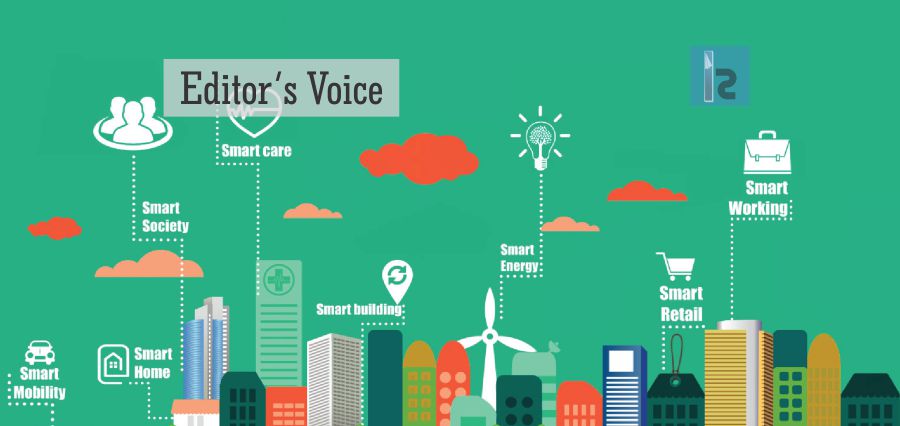With rapid urbanization and an ever-growing population, the cities are handling a lot today. A high concentration of population is slowly increasing pressure on the available resources like land and water which now need to be managed in a more efficient way. Making cities “smarter” or developing a “Smart City” is being touted as the solution to the impending problem.
A Smart City is defined as an urban area which uses different types of sensors to collect data and supply information used to manage the assets and resources efficiently. A Smart city uses technology to improve its existing infrastructure and add new service in order to support the growing population. It is developed to provide a safe, secure, environmental and efficient urban center with advanced infrastructures such as sensors, electronic devices, and networks to stimulate sustainable economic growth and a high quality of life.
Sensing the Issues
The first step in the developmental concept of smart cities is an Integrated Sensor Systems. A sensor is a device that detects and responds to Physical parameters like light, heat, motion, moisture, or pressure and converts them into an electronic signal, which can be interpreted by humans or can be stored in an autonomous system for reading or further processing. An Integrated sensor system is composed of multiple complementary sensors which are internally as well as externally connected via wireless network to a central unit that receives and processes data creating a wireless sensor network. This multi-layer networking is essential to satisfy the complex needs of cities and demands for information necessary for smart management.
Sensors are a crucial component of the whole system and the concept of a smart city. A smart city is capable of creating an efficient services delivery platform for public and the municipal by installing sensors in the city. It also creates a platform that allows the sharing of information and gives it for proper use to the public, city managers, businesses and professionals.
Classification and Types of Sensors
There are several ways in which sensors can be classified.
In the first classification of the sensors, they are divided into Active and Passive on the basis of presence or absence of an external power signal. Another classification is based on the means of detection used in the sensor like Electric, Biological, Chemical, Radioactive etc. Yet another classification is based on conversion phenomenon i.e. the input and the output like Photoelectric, Thermoelectric, etc. The final classification of the sensors is Analog and Digital Sensors on the basis of the output of data being continuous or discrete and digital.
There are several types of sensors that can be put to use in the smart city initiative based on their input. These are Temperature Sensor, Proximity Sensor, IR Sensor (Infrared Sensor) Pressure Sensor, Light Sensor, Smoke, Gas, and Alcohol Sensor, Touch Sensor, Color Sensor, Humidity Sensor, Tilt Sensor, Flow and Level Sensor and more.
Putting Sensors to Use
The sensors can be used for achieving the goal of optimal use of resources. They can be used to control, detect issues, make adjustments and manage the usage as per need. Here’s how sensors can help address various challenges in developing a smart city.
Water Management is very essential and it is estimated that a major amount of this precious liquid is often wasted due to leakages. Sensors fitted in pipes can detect these leakages in time. They can also be used to manage the irrigation system in the city and public parks.
Energy Management can be redefined using smart meters. They can give real-time energy consumption details to customers and alert the authorities about any snags or disrupted supplies and help to mend them in no time.
Infrastructure Management can help maintain lights, streets, public phone booths, public toilets and other basic things. Street lighting can be better managed with sensors which can help them turn off automatically in daylight, trigger an alarm when they are at fault or there is a theft, and be dimmed when areas have low activity etc.
Waste Management can be easier with sensors notifying the authorities when they are full and need to be emptied or they are damaged etc.
Transport Management is essential to avoid chaos or roads. Sensors can be used to manage parking lots, routes that are facing heavy traffic, clearing traffic for ambulances etc.
Pollution Management can be facilitated with sensors monitoring the air quality and sound level of the city and alarm the citizens and authority when the optimum levels fail.
Healthcare Management can utilize sensors and help the city hospitals to track accidents, breakouts, a spread of diseases, hygiene conditions in various areas.
Law and Order Management can put to use these sensors and video surveillance in order to check the city’s crime rate. Sensors can trigger an alarm in the police department in case of theft, sighting of wanted criminal and other cases.
The concept of Smart City has many layers to it with each layer carrying out its specific task and interacting with the others to achieve the common goal. Sensors form a very basic and eminent layer which helps in taking efficient decisions and managing the complete city. The whole task of analyzing the requirement and the exact solution should be handled with proper planning and without disrupting the current growth of cities. Implementation of the smart city concept will need collaboration among the scientists, professionals, government, municipal workers, and people in general who understand the issues ailing the cities currently.
-Sneha Sinha


